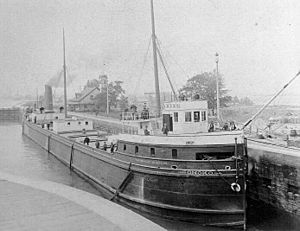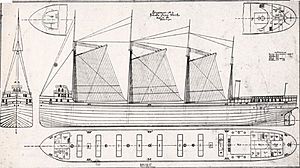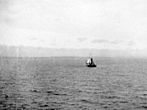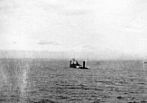SS Onoko facts for kids

Onoko prior to her sinking
|
|
Quick facts for kids History |
|
|---|---|
| Name | Onoko |
| Operator |
|
| Port of registry | |
| Builder | Globe Ironworks Company |
| Yard number | 4 |
| Launched | February 16, 1882 |
| Completed | 1882 |
| In service | March 31, 1882 |
| Out of service | September 15, 1915 |
| Identification | U.S. Registry #155048 |
| Fate | Sprang a leak and sank on Lake Superior with no loss of life |
| General characteristics | |
| Class and type | Bulk Freighter |
| Tonnage |
|
| Length | 302.6 ft (92.2 m) |
| Beam | 38.6 ft (11.8 m) |
| Height | 24.8 ft (7.6 m) |
| Installed power | 2 × Scotch marine boilers |
| Propulsion | Compound steam engine |
|
Onoko (Bulk Freight Steamer) Shipwreck
|
|
| Location | 6 miles south of Knife River |
| Nearest city | Duluth, Minnesota |
| Built | 1882 |
| Architect | Globe Iron Works Company; William H. Radcliffe |
| Architectural style | Freighter |
| MPS | Minnesota's Lake Superior Shipwrecks MPS |
| NRHP reference No. | 92000845 |
| Added to NRHP | July 23, 1992 |
The SS Onoko was a large iron ship that carried cargo on the Great Lakes. She was built in 1882 in Cleveland, Ohio. Onoko sank on September 14, 1915, in Lake Superior near Knife River, Minnesota. Many people believe Onoko was the first ship of her kind. She was a model for all the steel-hulled cargo ships that sailed the Great Lakes after her.
These types of ships made it possible to transport heavy goods cheaply. They carried things like iron ore, coal, and limestone. The wreckage of Onoko still lies at the bottom of Lake Superior. It was added to the National Register of Historic Places in 1992.
Contents
Building the Onoko
The Onoko (Official number 155048) was built by the Globe Iron Works Company. Her construction took place at Radcliffe's yard in Cleveland. She was launched into the water on February 16, 1882. The ship was very long, measuring 302.6 feet. She was also 38.6 feet wide and 24.8 feet tall.
Onoko was powered by a 900-horsepower compound steam engine. Two large Scotch marine boilers provided the steam for the engine. Phillip Minch of Vermilion, Ohio ordered the ship. He was part of the Minch Transportation Company and other investors. The ship was designed to use the new 16-foot deep channels. These channels opened in 1881 when the Weitzel Lock was built.
John H. Smith was in charge of building Onoko. He learned about iron shipbuilding in Scotland. Smith worked for the new Globe Shipbuilding Company in Cleveland, Ohio. This company was known for building boilers and engines.
On February 16, 1882, about five thousand people came to watch Onoko launch. Even though the weather was bad, many wanted to see it. At 3 p.m., Smith gave the signal. The ropes holding Onoko were cut. She slid smoothly into the water. Over the next few months, Onoko was finished. Her masts were put in place by Upson, Walton & Company.
Onoko at Work
First Journeys
Onoko was officially registered in Cleveland on March 31, 1882. Her first trip began on April 19, 1882. She left Cleveland at 11 p.m. and arrived in Chicago the next day around 2 p.m. She was carrying 2,536 tons of coal.
Captain W.H. Pringle, Onoko's captain, said the ship "behaved splendidly." He also said she "steered like a yacht." By April 25, Onoko was loaded with wheat. She was heading to Buffalo, New York. She left at 3:30 p.m. and unloaded 88,140 bushels of wheat. None of the cargo got wet. People thought Onoko could carry even more, about 115,000 to 120,000 bushels of wheat. For oats, her capacity was around 155,000 bushels.
A newspaper, the Buffalo Courier, reported on Onoko's arrival. It said she arrived with over 88,000 bushels of wheat. She left Chicago on Tuesday at 4:20 PM. Her trip took three days and nineteen and a half hours.
A Ship's Looks
On May 2, 1882, the Buffalo Courier wrote something not so nice about Onoko's appearance. They said she was the largest ship on the lakes, but also the "homeliest." They compared her to a "huge canal boat" with a smokestack. They also said her painting was "but a daub" and called her an "eye-sore."
The owners of Onoko did not like this criticism. On May 5, 1882, the Cleveland Herald responded. They said the Buffalo paper's comments were "ridiculous." They revealed that someone from Buffalo had tried to buy Onoko. This person wanted to buy her for more than she cost to build. Some owners wanted to sell, but others did not. The deal fell through. The owners were happy with how the ship worked.
Onoko was very successful in her first two years. She carried many bulk cargoes on the Great Lakes. On August 22, 1884, the Cleveland Herald reported that Onoko was "even more successful than her owners hoped for."
Changes and Incidents
In 1895, two of Onoko's masts were taken off. Her wooden front deck was replaced with a steel one. A steel pilothouse was also added. In 1896, her boilers were replaced with two new Scotch marine boilers.
On May 16, 1896, Onoko crashed into the schooner Mary D. Ayer. This happened in heavy fog on Lake Michigan. Sadly, some sailors on the Mary D. Ayer lost their lives. In 1901, Onoko's wooden main deck was replaced with steel. Later that year, the Nicholas Transportation Company became the sole owner of Onoko. They bought out all other investors. Between 1907 and 1908, Onoko had steel cabins installed at the back.
In 1910, Captain Harry Stewart became Onoko's master. On December 1, 1910, Onoko ran aground. This happened during a snowstorm near Southeast Shoal. Three tugboats, including Harding and Rescue, helped free her. She was carrying coal at the time. The Duluth Herald reported that Onoko was not in serious danger. The tugs refloated her without much damage. On October 7, 1912, Onoko sprang a leak. She was intentionally beached in the Apostle Islands. The repairs to her hull were not expensive.
Onoko's Last Journey
In early September 1915, Onoko hit the bottom while leaving a grain elevator in Duluth. She managed to free herself and leave the harbor safely. It is believed this incident caused the leak that sank her a few days later.
On September 15, 1915, Onoko left Duluth, Minnesota. She was carrying 110,000 bushels of wheat to Toledo, Ohio. She developed a big leak near Knife Island, about 15 miles from Duluth. The Duluth Herald reported on September 15, 1915:
The sea was calm, and everything was fine. Then, the engineer, J.J. Higgins, told Captain W.R. Dunn that the ship had a leak. Water was coming in fast under the engines. When Captain Dunn checked, water was gushing in. In minutes, it put out the fires. The captain knew the situation was hopeless. He ordered everyone into the lifeboats.
Everyone on board got to safety. This included Mrs. C.R. Cranbee, the steward's wife, and a passenger named Antone Rehor. They had no trouble getting into the boats. In a few minutes, the ship's back filled with water. She lifted her front into the air and sank stern first.
The lifeboats were a safe distance away. The crew was not worried. Before they left the ship, they saw another ship, the Renown. This tanker belonged to the Standard Oil company. It had left Duluth shortly after Onoko. The Renown was coming at full speed. Its captain had noticed Onoko was sinking. In a few minutes, Renown, with a barge named C in tow, arrived. It picked up everyone from the lifeboats. Renown then turned around and took the crew back to Duluth. A tugboat met them outside the Duluth canal. It took Onoko's crew off. Renown and its tow then continued their journey.
Onoko Today
The wreck of Onoko was found on April 10, 1988. Jerry Eliason and Kraig Smith discovered it. They used a special device called a depth finder. The wreck lies upside down in 220 feet of water. Her back end is almost completely buried in mud. The ship's hull is broken almost in half. The break is right in front of her boilers. Many items from inside and outside the ship are scattered around the wreck. Her cargo of grain is still in her cargo hold. It is against the law to remove anything from the wreck without permission. This is because it is protected by the State of Minnesota.











